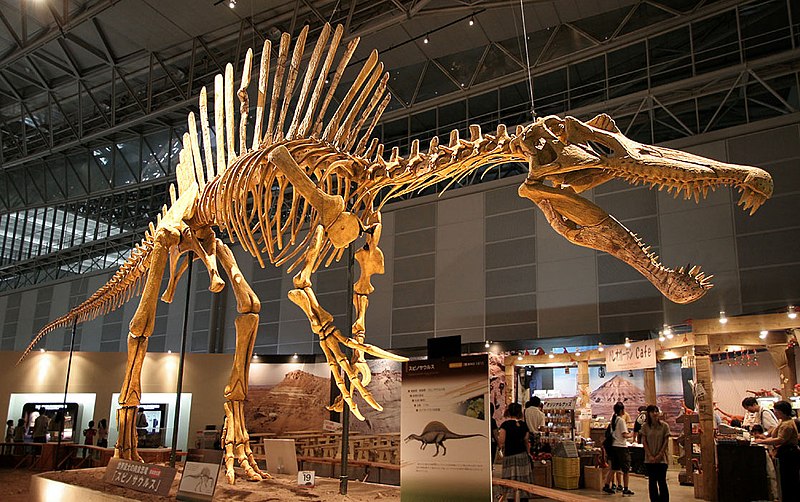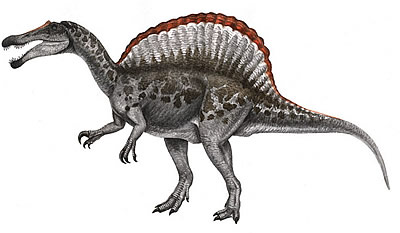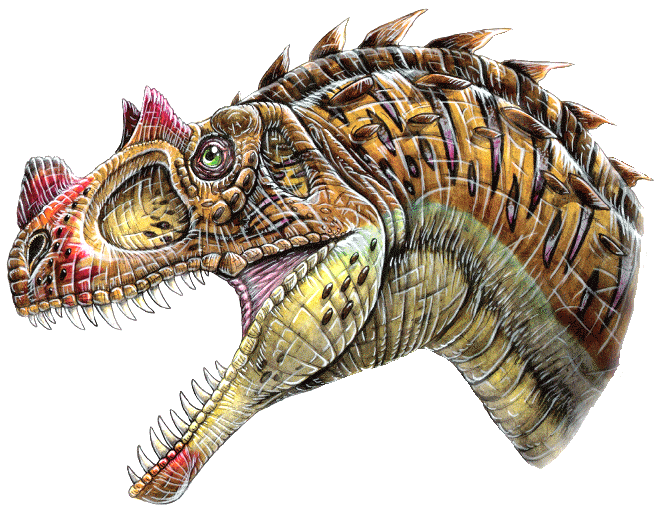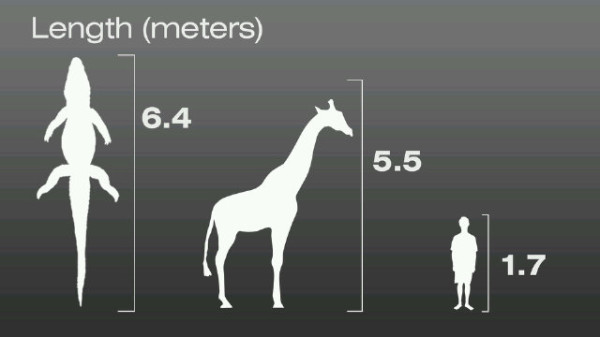|
|
Post by Canid Cetus Aves on Oct 15, 2011 12:30:29 GMT -5
Tyrannosaurus Like other tyrannosaurids, Tyrannosaurus was a bipedal carnivore with a massive skull balanced by a long, heavy tail. Relative to the large and powerful hindlimbs, Tyrannosaurus forelimbs were small, though unusually powerful for their size, and bore two clawed digits. Although other theropods rivaled or exceeded Tyrannosaurus rex in size, it was the largest known tyrannosaurid and one of the largest known land predators, measuring up to 12.8 m (42 ft) in length, up to 4 metres (13 ft) tall at the hips, and up to 6.8 metric tons (7.5 short tons) in weight. By far the largest carnivore in its environment, Tyrannosaurus rex may have been an apex predator, preying upon hadrosaurs and ceratopsians, although some experts have suggested it was primarily a scavenger. The debate over Tyrannosaurus as apex predator or scavenger is among the longest running in paleontology. Spinosaurus Spinosaurus may be the largest of all known carnivorous dinosaurs, even larger than Tyrannosaurus and Giganotosaurus. Estimates published in 2005 and 2007 suggest that it was 12.6 to 18 metres (41 to 59 ft) in length and 7 to 20.9 tonnes (7.7 to 23.0 short tons) in weight. The skull of Spinosaurus was long and narrow like that of a modern crocodilian. Spinosaurus is thought to have eaten fish; evidence suggests that it lived both on land and in water like a modern crocodilian. The distinctive spines of Spinosaurus, which were long extensions of the vertebrae, grew to at least 1.65 meters (5.4 ft) long and were likely to have had skin connecting them, forming a sail-like structure, although some authors have suggested that the spines were covered in fat and formed a hump. Multiple functions have been put forward for this structure, including thermoregulation and display. Dal Sasso et al. (2005) assumed that Spinosaurus and Suchomimus had the same body proportions in relation to their skull lengths, and thereby calculated that Spinosaurus was 16 to 18 meters (52 to 59 ft) in length and 7 to 9 tonnes (7.7 to 9.9 short tons) in weight. The Dal Sasso et al. estimates were criticized because the skull length estimate was uncertain, and (assuming that body mass increases as the cube of body length) scaling Suchomimus which was 11 meters (36 ft) long and 3.8 tonnes (4.2 short tons) in mass to the range of estimated lengths of Spinosaurus would produce an estimated body mass of 11.7 to 16.7 tonnes (12.9 to 18.4 short tons). Okay guys. I'm not sure on the Spinosaurus weight. But last time checked, I read that it was about 12 tonnes. So I have posted the different estimations of it's size above.
|
|
|
|
Post by Deinobrontornis on Oct 16, 2011 19:47:09 GMT -5
Ahh! The classic Tyrannosaurus vs. Spinosaurus poll!
Call me a fanboy if you will, but I vote for the Spinosaurus. Why? There are several reasons. The first one would be size advantage. Whereas Tyrannosaurus averaged about 6 tons and maxed out at 9 tons, Spinosaurus averaged between 9-12 tons and maxed out at some 20-23 tons. Another reason would weapons. Tyrannosaurus had an enormous jaw lined with 7 inch long, steak knife-like teeth and 2 practically useless arms. Spinosaurus, on the other hand, had 7 foot long arms with curved, 15 inch long claws. And while its jaw may have not been as powerful or as strong as Tyrannosaurs' jaw, it was still quite useful. Monsters Resurrected said that Spinosaurus had jaws with long, cone-like teeth designed for slicing, shaking, and tearing, similar to crocodile's jaw. And we all know how dangerously effective a crocodile's jaw is!
|
|
|
|
Post by Super Communist on Oct 16, 2011 20:19:49 GMT -5
I do not know where you came out with the 20-23 ton figure from. Last time I checked 12 tons was the max for spinosaurus. Monster resurrected was an extremely inaccurate show and if you watch the much more up to date planet dinosaur, spinosaurus was unable to effectively kill animals one fifth its size without the use of its forearms. Now look at these two images, spinosaurus and crocodiles actually had skulls vastly different from each other. Crocodiles seemed to have much more robust skulls at similar sizes.   Anonymous from carnivora made a good point on spinos forearm and jaw use. If you look at this picture spinosaurus arm's weren't actually that large compared to its body either.  As you can see it was unable to use its arms without rearing up its head quite a bit, and when it did it would be unable to use its jaws, so its really a lose-lose situation. In my opinion despite spino's large size advantage I think that this match is fifty-fifty. |
|
|
|
Post by Deinobrontornis on Oct 17, 2011 9:13:52 GMT -5
List of Spinosaurus size estimates: 12-23 tons and 12.9-18.4 tons : Therrien, F.; and Henderson, D.M. (2007). "My theropod is bigger than yours...or not: estimating body size from skull length in theropods". Journal of Vertebrate Paleontology 27 (1): 108–115. P.S. Read the description next time before making a statement of doubt next time, please. I actually seem some similarity in the two skulls. The skull certainly resembles a gharial's skull:  Although I will say the gharial's teeth look sharper. But on the other hand, Spinosaurus' teeth appear more robust. And since the skull is 5-7 feet long, you cannot deny that the force produced by such a jaw is going to be immense; certainly it will harm Tyrannosaurus in at least some way. AHAHAHAHA!! It really depends on what you are comparing them to! If you compare the arms to the arms of an ape or early proto-crocodilian, that statement is true. But among Theropods, they're very large. 7-foot-long arms followed by another 15 inches of claws is extremely long compared to Tyrannosaur's arms or a Carnosaur's. And since Spinosaurus' opponent has arms which are completely useless, the claim that Spinosaurus has short arms makes it all the more dubious. In fact, Spinosaurus' arms are long enough that it was even suggested in the 1070s that Spinosaurus may have used them to walk quadrupedially for brief periods of time.[1] Source: [1] The Ultimate Book of Dinosaurs (Parragon Publishing, 2000 A.D.) p. 146 Ahh! This position! If you haven't seen before, Theropods tilt their bodies into a horizontal position when running. Spinosaurus' arms are actually in a good position to strike when standing still.   Is this not enough to convince you? Look at this.  As you can see, Spinosaurus does not need to rear up much at all to strike Tyrannosaurus. I look forward to your reply! ;D |
|
|
|
Post by Super Communist on Oct 17, 2011 14:18:17 GMT -5
I did but I remember that most people on carnivora thought that the twenty ton claim was ridiculous and personally I agree.
Yes obviously they can inflict damage but it would only cause minor injuries at best. Many tyranosaurus fossils have shown that they can survive getting bit on the head by others of there kind. Conical teeth design is good for gripping but not for killing, unless you are able to utilize the environment like crocodiles and alligators.
I was comparing them to mammals, I am aware that they are very large compared to other theropods, though I doubt that they were able to walk on all fours at all.
I know that they are able to strike with them, but they would lose the ability to use their jaws which is why I do not consider the spinosaurus "extra weaponry" that advantages.
Oh and I should remind you that trex has two other major advantages over spino that we forgot to mention, binocular vision and agility. With eyes at the of its head, spinosaurus will be forced to continuously move its head around to keep its opponent in its line of vision, and assuming the two don't rush each other trex could very well outmaneuver the enormous spinosaurus. A study has shown that it took two seconds for trex to make a forty five degree turn, imagine how long it would take a twelve ton spinosaurus?
|
|
|
|
Post by Deinobrontornis on Oct 17, 2011 14:51:03 GMT -5
Maybe not as an average weight, but what about as a maximum weight? After all, Spinosaurus was up to 59 feet long! Do you really think a Dinosaur that long weighing 20 tons would be ridiculous? Well Spinosaurus can't perform a death roll like crocodiles can, but could rapidly shake its jaws like a crocodile can. Gripping into Tyrannosaurus' hide with its teeth and shaking violently could be a very effective for ripping small to medium sized chunks of flesh. If Spinosaurus could perform that a couple of times, it would certainly be enough to cause Tyrannosaurus massive blood loss and become weary in the fight. Spinosaurus could also target smaller areas such as the tail and arms to get a well placed bite in. And of course, curved claws would serve as good defensive and offensive weapons. Striking the head with them would be one example of an effective offensive weapon.   Seriously?? You're trying to compare mammals with dionsaurs? Where did that idea come from? You through off the entire conversation and context when do that! Well...they may only be able to be used one at a time, but switching positions to use both the jaws and claws only takes a couple of seconds. Okay. So Tyrannosaurus an eyesight advantage. But arguing this would make it harder for Spinosaurus to keep Tyrannosaurus in its line of vision couldn't further from the truth! If Spinosaurus lacked binocular vision, then it could have only had peripheral vision. And while peripheral vision makes harder to discern distances, it gives an animal a much wider scope of vision of its surroundings. Would you please give me a source to this study? |
|
|
|
Post by Super Communist on Oct 17, 2011 15:28:28 GMT -5
Yes I do for a carnivorous animal that is. I do not see why a spinosaurus would need to be that large to kill twenty foot long fish.
While spinosaurus is struggling to cause minor lacerations on its opponent trex will be taking out entire chucks of flesh.
The reason I am comparing them is because most people seem to get the impression that spinosaurus can use it forearms as effectively as bears and felines.
In a fight several seconds can be a matter of life and death.
Having eyes at the side of its head is an extreme disadvantage, because its blind spot is right in front of its face and most of the time that's where its opponents going to be at. So spinosaursus going to have to constantly swivel your head at awkward angles to keep tyrannosaurus in its sight.
What do you mean? A study on the advantages of binocular vision, or a study showing that spinosaurus lacked it?
|
|
|
|
Post by Canid Cetus Aves on Oct 17, 2011 16:59:51 GMT -5
Well based on that size comparison, I say the New Spinosaurus would win mostly because of it's size and superior weapons.
|
|
|
|
Post by Deinobrontornis on Oct 18, 2011 15:24:36 GMT -5
Well communist, Spinosaurus DID reach that size. For one, it did not eat just fish. In fact, Spinosaurus was the LEAST aquatic of all Spinosaurids. Like a bear, Spinosaurus was probably an opportunist. Besides fish, it also consumed carrion, small animals (at least relative to its size!  ), and crocodilians. Spinosaurus also needed such a large size because of pack predators like Rugops, and even other large reptiles like Sarcosuchus and Carcharodontosaurus. Where is it going to bite?  The only real vulnerable spot on Spinosaurus is the neck, and that's protected by the forearms, jaw, and sail! That is a LOT of defenses to break through to get to fatal spot. I couldn't see the connection to felines, but I could see a connection to bears. Spinosaurus' arms may not be as long dimensionally, the claws are just as long proportionally and the claws themselves are even sharper than bear claws!  So I guess Tyrannosaurus taking 2 seconds to make 45 degree turn should also mean a matter of life of death! Quite with the agility argument! It just doesn't work when two living Godzillas are fighting each other! I agree that Spinosaurus would have problems with depth perception and that would be an advantage for Tyrannosaurus, but you need to understand an animal with peripheral vision does not need to move its head into awkward positions when it has A WIDER VIEWING RANGE! No! You said a study proved Tyrannosaurus took 2 seconds just to rotate 45 degrees. I want you to show me that study! |
|
|
|
Post by Super Communist on Oct 18, 2011 15:39:06 GMT -5
May I see reliable studies on that? One does not need to be four time the size of the rest to keep itself safe and tackle "small" prey. Ripping out a huge chunk of flesh could cause spinosaurus to die of shock or blood loss. I am not sure about that, this claw looks very sharp to me.  It does when your opponents even slower than you, spinosaurus's large spine would probably make the animal even more cumbersome than a similar sized tyranosaurus. The thing is animals have a tendency to fight in front of each other, if tyrannosaurus decides to attack head on spinosaurus will be forced to either turn around or swivel its head to the side to keep its opponent in its line of vision. Note this study was made when tyrannosaurus was thought to max out at eight tons. news.nationalgeographic.com/news/2007/06/070607-trex-dinosaur.html |
|
|
|
Post by Deinobrontornis on Oct 18, 2011 16:08:10 GMT -5
It doesn't take any studies to show that Spinosaurus lived in an enviroment which contained predators NEARLY the same size as Spinosaurus. Just take a look at these two predators. Sarcosuchus: en.wikipedia.org/wiki/SarcosuchusCarcharodontosaurus: en.wikipedia.org/wiki/CarcharodontosaurusBut HOW is Tyrannosaurus supposed to rip out that chunk of flesh if the vulnerable areas are well protected and other areas lack a good grip for such a bite. Okay! But in general, bears lacking retractable claws and always walking on them generally means they get worn down fast. How about instead of making that a "probably", you make it a "definitely" by proving it! Okay and okay! |
|
|
|
Post by Canid Cetus Aves on Oct 18, 2011 20:53:54 GMT -5
By the way. Can we find alternate sources than Wikipedia for threads like these? Wikipedia is a good source, but the information could be tampered with and therefore unreliable.
|
|
|
|
Post by Deinobrontornis on Oct 18, 2011 22:29:21 GMT -5
By the way. Can we find alternate sources than Wikipedia for threads like these? Wikipedia is a good source, but the information could be tampered with and therefore unreliable. For the most part, this is just general information and Wikipedia gets that job done. Unless you can find some actual errors in the information, it is good enough to leave it that way. |
|
|
|
Post by Canid Cetus Aves on Oct 18, 2011 22:48:11 GMT -5
By the way. Can we find alternate sources than Wikipedia for threads like these? Wikipedia is a good source, but the information could be tampered with and therefore unreliable. For the most part, this is just general information and Wikipedia gets that job done. Unless you can find some actual errors in the information, it is good enough to leave it that way. Okay. |
|
|
|
Post by apexpredator7 on Nov 30, 2011 15:00:34 GMT -5
spino, it is too big to handle for the tyrannosaurus, and there is a case of a false ghavial eating a man so spino
|
|























 Seriously?? You're trying to compare mammals with dionsaurs? Where did that idea come from? You through off the entire conversation and context when do that!
Seriously?? You're trying to compare mammals with dionsaurs? Where did that idea come from? You through off the entire conversation and context when do that! ), and crocodilians. Spinosaurus also needed such a large size because of pack predators like Rugops, and even other large reptiles like Sarcosuchus and Carcharodontosaurus.
), and crocodilians. Spinosaurus also needed such a large size because of pack predators like Rugops, and even other large reptiles like Sarcosuchus and Carcharodontosaurus. The only real vulnerable spot on Spinosaurus is the neck, and that's protected by the forearms, jaw, and sail! That is a LOT of defenses to break through to get to fatal spot.
The only real vulnerable spot on Spinosaurus is the neck, and that's protected by the forearms, jaw, and sail! That is a LOT of defenses to break through to get to fatal spot.

